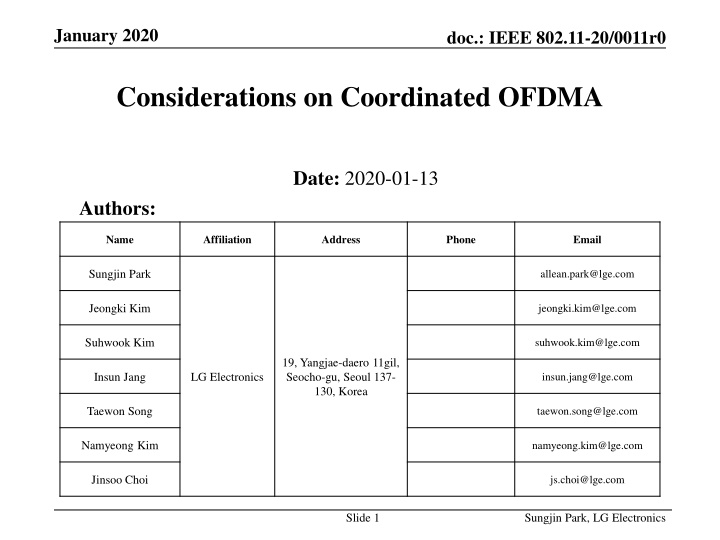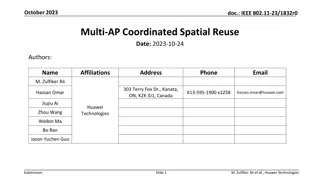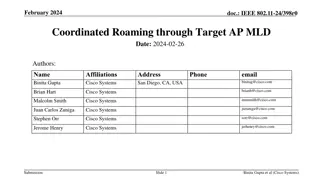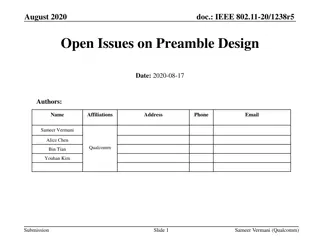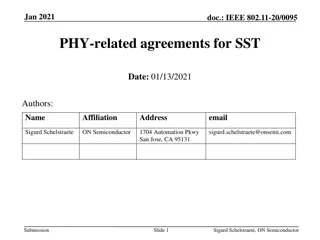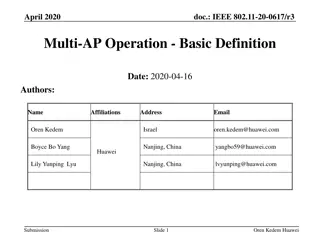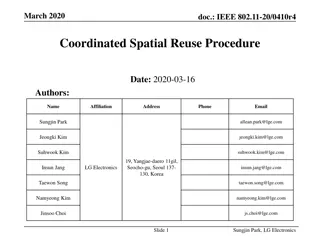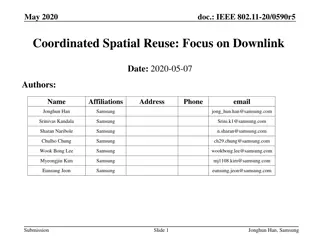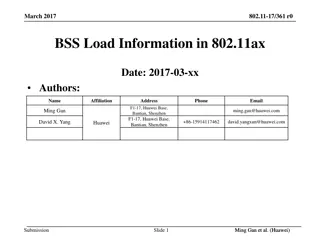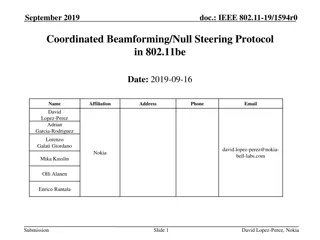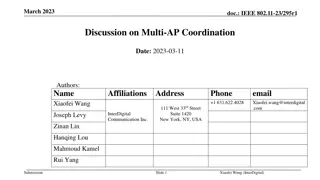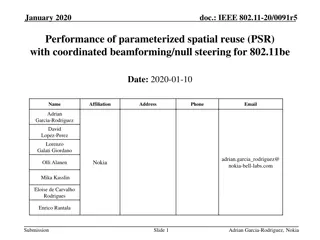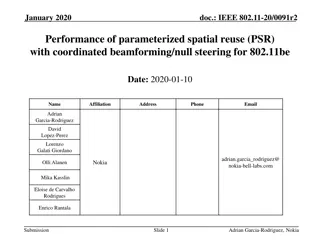Considerations on Coordinated OFDMA Operation in IEEE 802.11
The document discusses the Coordinated OFDMA (C-OFDMA) operation as a part of Multi-AP coordination schemes within the IEEE 802.11 standard. It covers resource allocation options, topology considerations, resource allocation methods, capability announcement procedures, and negotiation processes between Master APs and Slave APs for C-OFDMA configuration. The operation involves APs establishing connections, allocating bandwidth, and coordinating to enhance wireless communication efficiency.
Download Presentation

Please find below an Image/Link to download the presentation.
The content on the website is provided AS IS for your information and personal use only. It may not be sold, licensed, or shared on other websites without obtaining consent from the author.If you encounter any issues during the download, it is possible that the publisher has removed the file from their server.
You are allowed to download the files provided on this website for personal or commercial use, subject to the condition that they are used lawfully. All files are the property of their respective owners.
The content on the website is provided AS IS for your information and personal use only. It may not be sold, licensed, or shared on other websites without obtaining consent from the author.
E N D
Presentation Transcript
January 2020 doc.: IEEE 802.11-20/0011r0 Considerations on Coordinated OFDMA Date: 2020-01-13 Authors: Name Affiliation Address Phone Email Sungjin Park allean.park@lge.com Jeongki Kim jeongki.kim@lge.com Suhwook Kim suhwook.kim@lge.com 19, Yangjae-daero 11gil, Seocho-gu, Seoul 137- 130, Korea Insun Jang LG Electronics insun.jang@lge.com Taewon Song taewon.song@lge.com Namyeong Kim namyeong.kim@lge.com Jinsoo Choi js.choi@lge.com Slide 1 Sungjin Park, LG Electronics
January 2020 doc.: IEEE 802.11-20/0011r0 Introduction The Coordinated OFDMA (C-OFDMA) operation has been discussed as one of the Multi-AP coordination schemes. In C-OFDMA operation, there are two options of resource allocation to be considered. This contribution deals with detailed procedures of C-OFDMA operation with considerations on resource allocation. Slide 2 Sungjin Park, LG Electronics
January 2020 doc.: IEEE 802.11-20/0011r0 Topology of C-OFDMA We consider the following environments. Each AP can establish its own BSS STA a and STA b are associated with AP 1 in BSS 1. STA c and STA d are associated with AP 2 in BSS 2. APs are connected each other with wireless backhaul. APs which are hearable each other can participate in C-OFDMA. Slide 3 Sungjin Park, LG Electronics
January 2020 doc.: IEEE 802.11-20/0011r0 Resource allocation in C-OFDMA There are two options for the method of resource allocation in C-OFDMA. Option 1: Slave AP schedules RU to be allocated to the STA associated with itself, and the allocated RU should be within the allocated bandwidth from the Master AP. Option 2: Mater AP schedules RU to be allocated to the STA associated with Slave AP as well as the STA associated with Master AP, and the allocated RU should be within the entire bandwidth used in C-OFDMA. Slide 4 Sungjin Park, LG Electronics
January 2020 doc.: IEEE 802.11-20/0011r0 C-OFDMA capability announcement Both options follow same procedure of C-OFDMA capability announcement. APs can discover each other by receiving Beacon frame or management frames sent by neighboring APs. When the AP sends Beacon frame or management frame, the neighboring AP should be informed that there is a capability and an intention to participate in C-OFDMA operation. APs know which of neighboring APs is hearable and has C-OFMDA capability and intention. Slide 5 Sungjin Park, LG Electronics
January 2020 doc.: IEEE 802.11-20/0011r0 Negotiation for resource allocation Mater AP and Slave APs establish C-OFDMA configuration set. The AP which obtains TXOP and initiates C-OFDMA operation is the Master AP. The AP which is coordinated by Master AP is the Slave AP. Master AP selects neighboring APs as candidate Slave APs and requests information for resource allocation. Slave AP responds to the Master AP if the channel status of Slave AP receiving the request from Master AP is idle. Based on the information reported by Slave APs, Master AP finally selects the Slave APs to participate in C-OFDMA. Slide 6 Sungjin Park, LG Electronics
January 2020 doc.: IEEE 802.11-20/0011r0 Negotiation for resource allocation (Cont.) The information required for resource allocation between Master AP and Slave AP is as follows: Option 1 Master AP needs Slave AP s buffer status (e.g., BSR). Mater AP needs Slave AP s available channels (e.g., BQR) or preferred channels of the available channels. Based on these information, the Master AP allocates bandwidth to the Slave AP. Option 2 Based on these information, the Master AP schedules RU allocated to the STAs associated with the Slave AP as well as the Master AP. Master AP needs the identifiers (with CQI) of STAs associated with Slave APs. Master AP needs the resource size for STAs associated with the Slave AP. Slave AP may report information of only specific STAs to reduce overhead. Slide 7 Sungjin Park, LG Electronics
January 2020 doc.: IEEE 802.11-20/0011r0 Channel switching Channel switching procedure is only needed for the option 1, the option 2 doesn t need this procedure. Based on the results of negotiation, the Master AP allocates bandwidth of 20MHz unit to the selected Slave APs for C-OFDMA data transmission. The selected Slave AP informs STAs belonging to its BSS to switch the operating channel into the allocated channel. The Slave AP may inform channel switching to only specific STAs participating in C-OFDMA. Unnecessary channel switching of STAs not participating in C- OFDMA can be prevented. The Slave AP and STAs may switch operating channel back at the end of TXOP duration or by an explicit indication by Master AP. Slide 8 Sungjin Park, LG Electronics
January 2020 doc.: IEEE 802.11-20/0011r0 C-OFDMA data transmission The Master AP triggers the selected Slave APs to send data by using C- OFDMA, the information included in the trigger frame is as follows: Option 1 If Master AP and Slave APs send data in synchronization, the Master AP indicates TX parameters to the Slave APs: the number of EHT LTF symbols, GI, the number of SIG-B symbols, PPDU length and etc.. Option 2 Master AP indicates TX parameters to the Slave APs: the number of EHT LTF symbols, GI, the number of SIG-B symbols, PPDU length and etc.. Master AP indicates the information of RU allocation for the STAs associated with the Slave AP as well as the Master AP. Slide 9 Sungjin Park, LG Electronics
January 2020 doc.: IEEE 802.11-20/0011r0 C-OFDMA data transmission (Cont.) Master AP and triggered Slave APs send data by using C-OFDMA. Option 1 Slave AP sends data through allocated bandwidth within the bandwidth used in C- OFDMA. Slave AP allocates RU to the STA associated with itself. The allocated RU should be within the allocated bandwidth from the Master AP. Option 2 Slave AP sends data through allocated RUs indicated by the Master AP within the entire bandwidth used in C-OFDMA. Slide 10 Sungjin Park, LG Electronics
January 2020 doc.: IEEE 802.11-20/0011r0 Comparison of options (Efficiency of RU allocation) Case 1: - In BSS 1, Channel 1 is suitable for STA a and channel 2 is suitable for STA b. - In BSS 2, Channel 1 is suitable for STA c and channel 2 is suitable for STA d. Option 2 Option 1 Regardless of the CQI of the STAs, RUs should be allocated to the STAs only within the bandwidth allocated to the AP itself. In consideration of the CQI of the STAs, the RUs can be allocated to the most suitable STA. Slide 11 Sungjin Park, LG Electronics
January 2020 doc.: IEEE 802.11-20/0011r0 Comparison of options (Channel Utilization) Case 2: - In BSS 1, STA a, b, c participate in C-OFDMA. - In BSS 2, STA d participates in C-OFDMA. - M-AP needs more resources than S-AP A. Option 2 Option 1 In consideration of the buffer status of the APs, the bandwidth can be allocated flexibly to the AP. Regardless of the buffer status of the APs, the bandwidth should be allocated to the AP at least 20MHz channel unit. Slide 12 Sungjin Park, LG Electronics
January 2020 doc.: IEEE 802.11-20/0011r0 Summary for comparison of options Option 1 Option 2 Signaling overhead low High Efficiency of RU allocation low High Channel utilization low High Supporting C-OFDMA by using only single 20MHz channel Not supported Supported Slide 13 Sungjin Park, LG Electronics
January 2020 doc.: IEEE 802.11-20/0011r0 Conclusion This contribution introduces the procedures for operating C-OFDMA and the information required in each procedure. Capability announcement, negotiation, channel switching and data transmission. Furthermore, the considerations on resource allocation are introduced. Slide 14 Sungjin Park, LG Electronics
January 2020 doc.: IEEE 802.11-20/0011r0 Straw Poll Which option do you prefer to adopt in the TGbe? Option 1: Slave AP schedules RU to be allocated to the STA associated with itself and the allocated RU should be within the allocated bandwidth from the Master AP. Option 2: Mater AP schedules RU to be allocated to the STA associated with Slave AP as well as the STA associated with Master AP and the allocated RU should be within the entire bandwidth used in C- OFDMA. Slide 15 Sungjin Park, LG Electronics
